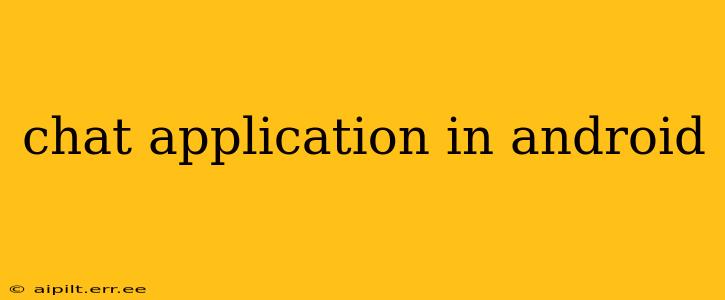Developing a chat application for Android involves a multifaceted process, demanding a strong understanding of several key technologies. This guide delves into the essential aspects of building a robust and engaging chat application, providing insights into the architecture, technologies involved, and potential challenges.
What are the core components of an Android chat app?
A functional Android chat app hinges on several core components working in harmony. These include:
-
Backend Infrastructure: This is the backbone of your application, responsible for handling user authentication, message storage, and real-time communication. Popular choices include Firebase, AWS Amplify, and custom server solutions using Node.js, Python (with frameworks like Django or Flask), or other backend technologies. The backend handles the heavy lifting of managing data and connections.
-
Database: You'll need a database to store user information and chat messages. Options range from cloud-based NoSQL databases like Firebase Realtime Database or MongoDB to relational databases like PostgreSQL or MySQL (often used with a server-side language). The choice depends on your scalability needs and data structure preferences.
-
Real-time Communication: For instant messaging, you need a real-time communication (RTC) solution. WebSocket technology is commonly used, often facilitated through platforms like Firebase or Socket.IO. These platforms provide APIs to manage connections and send messages efficiently.
-
UI/UX Design: The user interface (UI) and user experience (UX) are critical for a positive user interaction. A well-designed interface will make the app intuitive and enjoyable to use. This often involves using Android's Jetpack Compose or XML for layout design. Consider features like user profiles, message timestamps, read receipts, and group chat functionality.
-
Android SDK and Libraries: You’ll leverage the Android Software Development Kit (SDK) to build the Android application. Essential libraries include those for networking (handling HTTP requests and WebSocket connections), UI components, and data storage (depending on your database choice).
-
Security: Security is paramount. Implement robust security measures, including data encryption both in transit (HTTPS) and at rest (database encryption), secure authentication protocols, and protection against common vulnerabilities.
What technologies are used to build an Android chat app?
The specific technologies employed vary based on the project's complexity and requirements. However, some commonly used technologies include:
-
Programming Languages: Kotlin or Java are the primary programming languages for Android development. Kotlin is increasingly preferred for its modern features and conciseness.
-
Backend Frameworks: Node.js with Socket.IO, Python with Django or Flask, or cloud-based backends like Firebase or AWS Amplify are popular choices.
-
Databases: Firebase Realtime Database, MongoDB, PostgreSQL, MySQL.
-
UI Frameworks: Android Jetpack Compose or XML layouts.
-
Third-party Libraries: Libraries for networking, image loading, and other functionalities.
How can I add real-time features to my Android chat app?
Real-time features are essential for a compelling chat experience. This is usually accomplished using WebSockets, which establish a persistent connection between the client (your Android app) and the server. Whenever a message is sent, it's immediately broadcast to all connected users. Platforms like Firebase and Socket.IO simplify the process of implementing WebSockets.
What are the challenges in building a chat app for Android?
Building a chat app presents various challenges:
-
Scalability: Handling a large number of concurrent users and messages efficiently can be complex. The choice of backend and database significantly impacts scalability.
-
Real-time Performance: Maintaining low latency and ensuring timely message delivery is crucial for a smooth user experience.
-
Security: Protecting user data and preventing vulnerabilities requires careful attention to security best practices.
-
Cross-platform compatibility: If you want to support iOS, you need a backend solution that can handle both Android and iOS clients.
-
Error Handling: Robust error handling is vital to prevent crashes and provide informative error messages to the user.
What are some popular chat app libraries for Android?
While not strictly "libraries" in the traditional sense, platforms like Firebase provide comprehensive tools and services that greatly simplify chat app development, including real-time databases, authentication, and cloud functions. Other solutions may involve using specific networking libraries to handle WebSocket connections. The choice depends on your specific needs and architectural preferences.
This comprehensive guide provides a solid foundation for understanding the intricacies of building a chat application in Android. Remember, thorough planning, meticulous coding, and rigorous testing are crucial for creating a successful and engaging chat experience.
